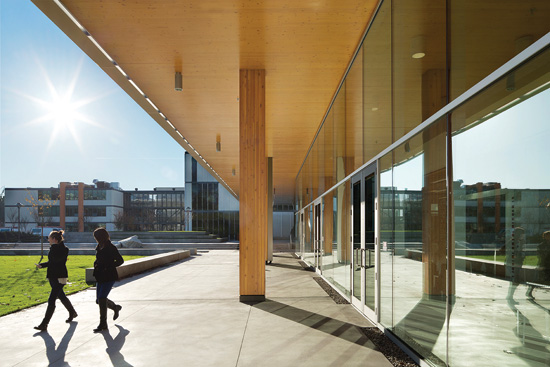Cross Laminated Timber
CLT Basics
As recently as 2011, CLT panels had to be shipped from manufacturers in Europe, but there are now a number of manufacturers and distributors working in North America.14
CLT manufacturers typically work closely with the project design team, offering technical support and material efficiency advice throughout the process. An engineer of record (EOR) is required for a CLT project. However, the CLT manufacturer often acts similarly to a truss or component manufacturer in that they have staff engineers and technicians that provide shop drawings and calculations to meet the EOR's specifications. On most projects, there is continuing interaction and support from the manufacturer to optimize the CLT system.
Panel sizes vary by manufacturer; typical widths are 2 feet (0.6 meters), 4 feet (1.2 meters), 8 feet (2.4 meters) and 10 feet (3 meters). Length can be up to 60 feet (18 meters) or more, and the thickness can be up to 20 inches (50.8 centimeters), though the current maximum available in North America is 16 inches (40.6 centimeters). Transportation is most likely the variable that will limit the CLT panel size, not the manufacturing capabilities.
North American manufacturers use formaldehyde-free interior/exterior polyurethane (PUR) structural adhesives with exceptional moisture performance. Adhesives must be qualified in accordance with ANSI/APA PRG 320 for bonding strength, moisture durability, elevated temperature performance, and heat durability. Boards are face-glued and then pressed, planed or sanded into panels. Using CNC precision machinery, the panels can be custom fabricated to create openings, compound angles and unique features requiring complex geometry to meet specific end-use applications.
| Earth Sciences Building | ||
The expansive 12,378-square-foot (1,150-square-meter) canopy of the Earth Sciences Building appears as a pristinely flat timber plate which emerges from the building and cantilevers past a glulam colonnade, giving the appearance that the entire canopy is made from a single, giant piece of CLT. The illusion is achieved by locating all supporting beams on top and hanging the panels from the underside with self-tapping screws, effectively creating an upside-down structure. The 32-square-foot (3-square-meter) double cantilever corners are strategically reinforced with hidden steel elements located on top or in the panel joints. |
Manufacturers in North America may use different species or mixes of species in their CLT products. Typical species are discussed in the ANSI/APA PRG-320 standard.
In general, however, designers don't select a particular species, but instead specify the required performance based on the application (floor, wall, roof, etc.) and request the appropriate grade of CLT. There are two routes manufacturers can take to achieve a specific stress grade—prescriptive and performance. “Layup” is the term for the arrangement of the timbers that make up a CLT panel. With the prescriptive route, a lamination size, species and grade-specific layup combination has been tested and is known to have certain structural design properties. With the performance route, any alternative layup can be used if it is proven by the manufacturer to qualify as meeting the CLT grade requirements. This approach is taken with other engineered wood products such as wood structural panels. With either route, the grade of the CLT will be third-party certified ensuring the stated design values.










